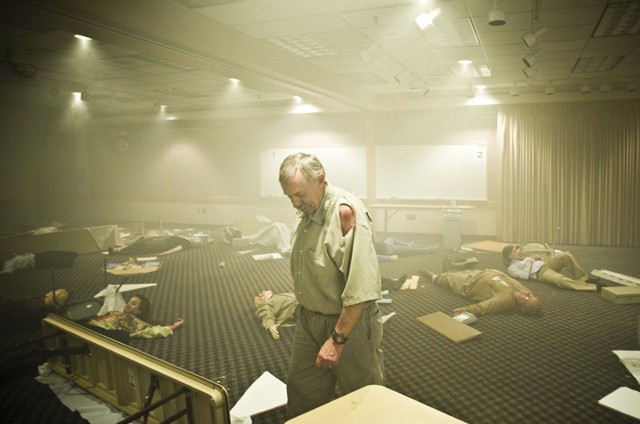A group of health science students tested their emergency preparedness skills as participants of the University of MinnesotaâÄôs first-ever mass casualty simulation, part of a workshop called Disaster 101. The simulation, which included scattered debris, bloody mannequins and trained actors, took place Friday and was organized by the Academic Health CenterâÄôs Simulation Center. Four simulations tested the students at different stages of the emergency response process. A group of evaluators, some of whom were present at the Interstate 35W bridge collapse in 2007, observed the studentsâÄô situational awareness, cooperation and communication skills. The students managed fleeing victims, and consoled and sorted patients according to their injuries, which included bruises, open wounds and broken limbs. Thirty students and 25 trained role players participated. Jason Moore, a fourth year pharmacy student, said he was struck by how realistic the victims looked and acted. He said the most challenging aspect was carrying out the tasks his group had planned beforehand. âÄúEverything fell apart, but then it got better with each simulation,âÄù he said. The simulation, which took 18 months to organize, is part of a five-year research project funded by a grant from the Centers for Disease Control and Prevention. The University is one of seven schools nationwide to receive the $8 million grant, about $683,000 of which was given to the simulation center to fund its research project. The project will analyze the effects of a simulated disaster on the students and simulated victims, and the results will be used nationwide. âÄúThere are high risks of disasters happening,âÄù said Jane Miller, director of the Simulation Center. âÄúWe know that large scale emergencies, whether theyâÄôre natural disasters or even terrorism, can happen, and everyone should be prepared for that âÄî especially students who are in the health sciences.âÄù âÄúWhat the evaluators could see was how much the studentsâÄô team skills and communication improved over the course of the afternoon,âÄù Miller said. âÄúThatâÄôs why weâÄôre doing immersive simulation; it makes such a profound impact in terms of student learning.âÄù Miller also said because the students came from clinical and not emergency preparedness backgrounds, their reactions were sometimes inappropriate, given some of the victimsâÄô injuries. âÄúGiven their training, that wasnâÄôt really surprising. WeâÄôll follow up on some of the specific injuries and treatment issues,âÄù she said. At the end of the simulation, all participants provided feedback about the experience. Miller said although the students knew the simulation had ended, some didnâÄôt want to leave the room. Khanh Phan, a fourth-year pharmacy student, said she had no expectations going into the simulation. âÄúI felt bad having patients there I couldnâÄôt help. It was troubling and it seemed real,âÄù she said. âÄúClearly, they needed some emotional closure with the patients and that wasnâÄôt something we had anticipated,âÄù Miller said. âÄúEven the patients wanted to talk to the students who had held their hand.âÄù Lawanna Holmes acted as a victim with an open chest wound. She said she actually felt helpless while acting out her role. âÄúI was really thinking about my loved ones,âÄù Holmes said. âÄúIt was difficult, and physically uncomfortable to just lay there.âÄù Miller said future simulations will include a closure process, and there will be four simulations per year.

Image by Jules Ameel
Participants begin the Disaster 101 simulation in the Earle Brown Continuing Education and Conference Center in St. Paul on Friday. The simulations were part of a research program funded by the Center for Disease Control to assess the effectiveness of live simulations for teaching emergency response skills.
Academic health center launches first disaster simulation
The results of the simulation will be used nationwide to study students’ emergency preparedness.
Published October 25, 2009
0

